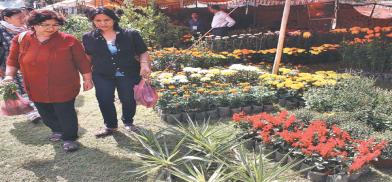Nepal’s flower industry withers amid pandemic
Prior to the Covid-19 pandemic, the flower industry in Nepal was worth over $20 million

Prior to the Covid-19 pandemic, the flower industry in Nepal was worth over $20 million. Today, it has been reduced to just half of that, mostly because of the disruption caused by the pandemic and the enduring social changes that came along with it.
Seminars and meetings, the regular events that used to create regular demand for the industry, have almost shifted to the online mode, and don’t require flower buke. Auspicious events, weddings, and big social gatherings have been curtailed for the last one and a half years.
Places of worship have also remained shuttered for a long time, and people have stopped buying flowers. The tourism sector, another sector that used to contribute to the industry, lies moribund as no tourists are coming, and this has impacted demand too.
After enduring the deadly Covid-19 second wave two months back, the cases are rising again in the country. On Saturday, it reported over 3000 cases. This week, the Himalayan country passed the grim milestone of 10,000 deaths due to the Covid-19. If it continues like this, authorities may start imposing restrictions.
Moreover, the industry insiders believe the good days do not look like returning anytime soon for flower growers because people are not celebrating much due to the Covid-19 pandemic, according to a report in The Kathmandu Post.
Players in the industry also deplore the lack of support from the government. Kumar Kasaju Shrestha, president of the Floriculture Association of Nepal, said that the flower business was worth more than $20 million annually before Covid-19.
“The yearly turnover has dropped by almost half (of the pre-pandemic level) to $12 million,” Kumar Kasaju Shrestha, the president of the Floriculture Association of Nepal, was quoted as saying by The Kathmandu Post. “We estimate that around 25 percent of the entrepreneurs involved in floriculture have left the business,” he added.
The industry was providing close to 50,000 direct and indirect jobs and over 1,000 entrepreneurs were involved in floriculture in almost 57 districts in the country. In the past few months, close to 25 percent of entrepreneurs have left the industry, Shrestha said, and over 35 percent of jobs vanished.
“Flowers imported from Europe are getting easy access to the local market, but there are few buyers for flowers grown locally in Ramkot or Kabhre,” he said. Domestically produced flowers face difficulty in finding a market due to the imported products.
Businessmen complain their products are not included in e-commerce platforms and are not sold online. Furthermore, the government has not provided any scheme to provide low-cost financing to the sector. Most of the industry relies on loans from cooperative societies, which are still costly.
(SAM)








Post a Comment